Mite Control in Dry-Cured Ham Aging Facilities
Dry-cured, or country-cured, ham is an American value-added ham with unique, aged flavors. The finished product is a treasured tradition, mainly in the southern United States. There are regional variations in the curing, smoking, and aging processes that result in small differences in the final flavor of the product.
American dry-cured hams are aged for a minimum of 3 months and a maximum of 2 years. Long-aged hams (18 to 24 months) are premium products with a minimum value of $10.40 per pound for bone-in ham, $17.50 per pound for boneless ham, and $39.95 per pound for sliced ham.
Ham aging rooms are maintained at temperatures ranging from 65 to 86°F and relative humidity values from 60 to 80 percent. These conditions are necessary for the characteristic flavor of the hams, but they are also optimal environmental conditions for ham mites to increase in numbers and potentially infest dry-cured hams.
The ham mite is a tiny spider relative that can reproduce into large populations and become a serious pest (Figures 1 and 2). The mite is adapted to feeding on aged meats, cheeses, semi-moist pet foods, and grain products between 15 and 45 percent moisture content. The ham mite can live on foods in cracks, crevices, and walls in food-processing buildings. In heavy mite infestations, mites can easily be seen crawling on hams and physical structures in the aging rooms (Figures 3 and 4).
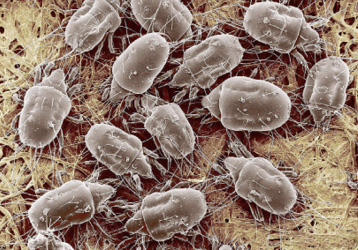
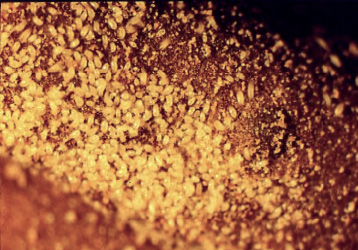
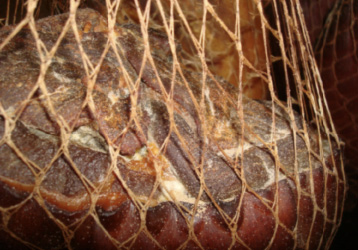
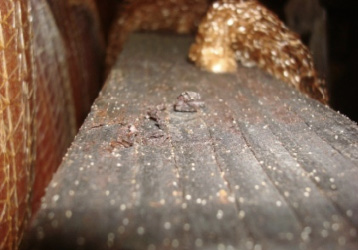
Ham mite infestations may lead to product losses of $1.4 million a year or more for facilities without proper pest management practices. Regulatory guidelines (USDA Title 9 Code of Federal Regulations 301.2) state that filth on a meat product that may “render it injurious to health” is adulteration, and many inspectors assess mites on dry-cured ham to be adulteration.
Losses can be mitigated if a mite infestation is discovered early and treated with fumigants. Methyl bromide has commonly been used to control visible mite infestations on dry-cured hams or racks, but the gas has been banned as an atmospheric ozone-depleting chemical. After several years of one-year emergency-use exemptions to the ban, the U.S. Environmental Protection Agency stopped allowing its use. The only source of methyl bromide available to dry-cured ham producers is in existing stocks held by ham or pest-control companies and is very expensive (more than $20 per pound in 2014).
Research has been conducted on the efficacy of potential methyl bromide alternatives to control ham mite infestations in the U.S. At the time of this publication, no alternatives have been discovered that are as effective at controlling mites as methyl bromide. However, some fumigants have the potential to control mite infestations. Therefore, a combination of these recently studied alternatives to methyl bromide can contribute to establishing an effective integrated pest management (IPM) program that will minimize the potential for infestations and financial loss. IPM programs have three components: pest prevention, pest monitoring, and mitigation.
This publication summarizes recent findings as well as currently available practices to help control ham mite infestations in dry-cured ham facilities.
Good Manufacturing Practices and IPM for Ham Mites
Sanitation
It is important to establish and follow good sanitation routines and Sanitation Standard Operating Procedures (SSOPs). Strictly follow your facility’s SSOPs, good manufacturing practices, and hazardous analysis and critical control points (HACCP) plan. Below are additional recommendations for your plant:
- Replace wooden racks with metal racks. Wooden racks may harbor grease and residues; metal racks are easier to clean. If using wooden racks, minimize cracks in the wood by sealing with a USDA-approved substance.
- Clean floors with hot water (131°F or hotter) and alkaline cleaner and sanitize with quaternary ammonium weekly (or on an established regular basis) to avoid grease and/or food buildup that can harbor ham mites. Use the manufacturer’s recommendations for cleaner and sanitizer concentrations. It is best to use low-pressure water. If cleaning is necessary while product is in the room, be extremely careful not to splatter floor water onto the products hanging above. After cleaning, dry the room with fans and then adjust the relative humidity to the proper aging room level.
- Thoroughly clean and sanitize the entire aging room, including racks, walls, floors, ceilings, and equipment at the end of each aging period and before hanging the next batch of hams. Cleaning should be completed at least twice a year (spring and fall). Long-aged hams still in the aging room can be rotated to a temporary room during cleaning and moved back to the rack once cleaning and sanitizing is completed and the room is dry.
- Limit employee/personnel access to the aging house, and require foot baths, hairnets, hats, and lab coats at each entrance to the aging rooms. Lab coats can be frozen for 24 hours before cleaning to kill any pests that may be present on the clothing.
General Pest Control
Insects and rodents are serious pests of food-processing buildings and can be carriers of ham mites. Keep buildings free of any weeds, turf grasses, trees, shrubs, or debris close to the exterior walls. A 1- to 2-foot gravel or solid surface “dead zone” is recommended to eliminate a harbor zone for insects, rodents, and mites. Additionally, inspect the building’s exterior and seal any openings.
Developing an Effective IPM Program
Ham Pests and Their Environment
There is no known effective biological control for ham mites in aging facilities. Ham mite treatment is needed when the infestation level exceeds the critical limit observed by a government meat inspector (such as one mite per one to two observations during an inspection, or a certain number of mites in a mite trap).
In addition to the ham mite, other insect pests that may infest dry-cured ham facilities include red-legged ham beetles, cheese skippers, and larder beetles (Figures 5 to 7). These pests can be effectively controlled with proper sanitation and commonly used insecticides and fumigants.
Typical mold growth on hams fosters and promotes mite growth and reproduction. Ham aging rooms are the ideal temperature and indoor humidity level for the development of molds, mites, and insects. Proper airflow and good HVAC/air system filtration are crucial to controlling mold and mite growth in ham aging rooms. Mold grows best on hams with a water activity (AW) above 0.9; therefore, reducing the water activity below 0.9 will minimize mold growth and possibly reduce mite populations (if water activity goes below 0.7). It is also important to ensure that incoming raw products are free from fungal contamination.
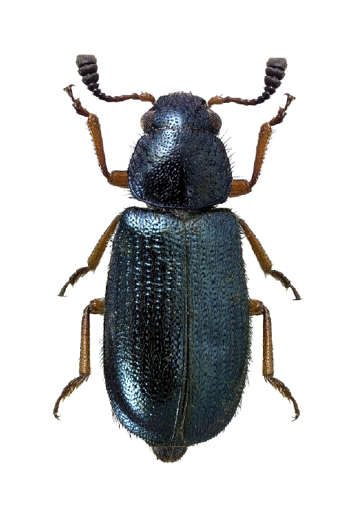
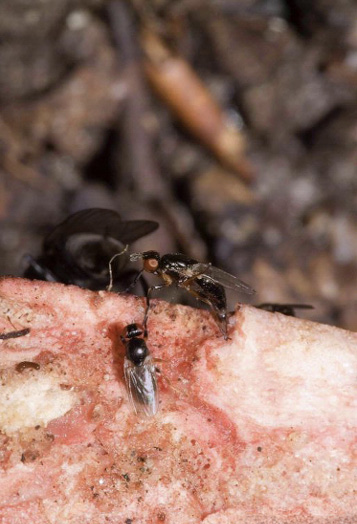
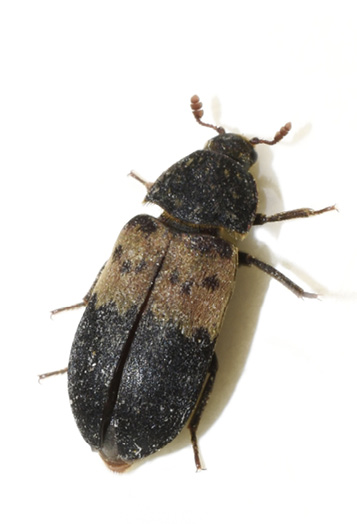
Physical Control
Light
Ham mites prefer darkness and tend to avoid light, especially red or white incandescent, fluorescent, or LED lights. It is recommended to use lights continuously (24/7) if possible. Use red LED lights at doors and entrances and inside aging rooms and buildings. Use white lights when employees are working in an aging room. To prevent off-flavors and off-colors, be sure the light does not constantly come in close contact with the hams.
Temperature
Ham mites cannot withstand high heat. After removing all of the hams from the aging room, use heat as a treatment to kill mites: hold each room at 104°F for 4 days, 108°F for 2 days, or 113°F for 1 day. Thoroughly clean and sanitize the rooms before bringing mite-free hams back into the room.
Additionally, ham mites are not able to tolerate cold temperatures. To use cold to kill ham mites, chill the facility (with freezing units) at -4°F for 12 hours, 14°F for 1 day, 19°F for 40 hours, or 23°F for 2 days. If you are not able to lower the entire aging room temperature, move infested hams to a walk-in freezer at -4°F for 24 hours.
Monitoring with Traps
Traps (Figures 8 and 9) are often used in product storage facilities to monitor pest populations year-round. Traps can detect the presence of mites and also monitor their relative numbers before a serious infestation occurs. Traps can also help determine the size of the mite population and when to take corrective action. Some mite traps are available commercially.

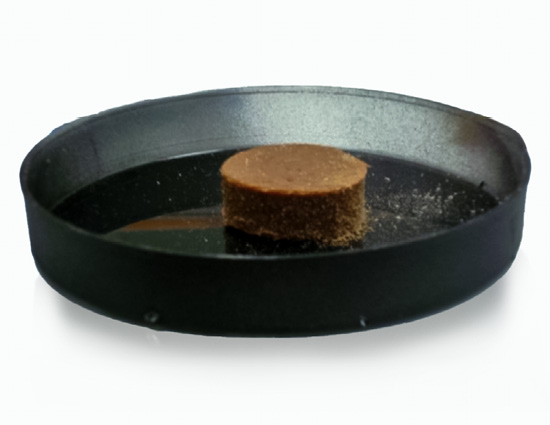
When trap captures suggest the mite population is high and observation samples exceed a critical limit (perhaps one mite per one to two sample units or 10 or more sample units per inspection), plan to take immediate corrective action. These actions may include:
- fumigation with methyl bromide (if available) or a registered alternative fumigant
- removing hams and conducting a commercial heat treatment
- freezing hams at a tolerable temperature and treating the whole aging room with an effective, legal process
A good IPM program for ham mites should include:
- a monitoring system
- traps or systematic visual inspections
- good records of mite population levels
- an understanding of the relationship between ham age and mite population levels
- good records of corrective actions taken when critical mite infestation limits are exceeded
Chemical Control
Food-Safe Compounds as Mite Deterrents
Multiple food-grade coatings are effective at inhibiting mite population growth. These coatings include propylene glycol, lard, ethoxyquin, BHT, BHA, carrageenan, propylene glycol alginate, and xanthan gum with propylene glycol. Research indicates that nets coated with some of these food-grade coatings can be used on hams during aging to prevent mites. Ham mites do not reproduce on these coatings and are likely to avoid contact with them. These nets could be part of an IPM plan to control mites through prevention.
Fumigation
Phosphine is a common grain fumigant that is readily available and allowed for use on aged meats and cheeses. Phosphine fumigation at 2,000 parts per million at 75°F or warmer is effective at killing all life stages of ham mites in 48 hours or less. However, a significant limitation of phosphine fumigation is that it corrodes copper and other metals. This can cause costly damage to most electrical equipment such as telephones, lighting systems, and HVAC systems. If phosphine is used, all electrical appliances and metal equipment in the aging house must be effectively sealed or ventilated.
Alternatively, if it is feasible to move hams out of an aging room, they could be taken to one or more metal shipping containers on-site to be safely fumigated with phosphine. The aging room and other buildings could then be given a thorough cleaning followed by heat treatment to control existing pests.
The fumigant sulfuryl fluoride (ProFume), which is registered in the U.S. for use on stored commodities like country hams, can control mobile mite stages, but some eggs may survive. Nevertheless, a sulfuryl fluoride fumigation is legal and relatively effective; a small population resulting from any surviving eggs could be kept low with proper sanitation and prevention measures.
Recent research shows the fumigants ethyl formate and propylene oxide can control mites. Commercial products of these two chemicals are used in other countries, but they are not yet registered for use as pesticides in ham facilities in the U.S.
|
Control Category |
Practices |
|
Sanitation |
|
|
Monitoring |
|
|
Other Pest Control |
|
|
Physical Control |
|
|
Chemical Control |
|
Personnel Training
Designate an IPM manager/technician who is trained in identifying and monitoring mite populations in the plant. This employee should establish and maintain the IPM program to control mite populations and infestations in aging houses. They should make sure sanitation and HACCP procedures are followed, review mite monitoring/control records monthly, and address any issues.
References
Abbar, S., Amoah, B., Schilling, M. W., & Phillips, T. W. (2016a). Efficacy of selected food-safe compounds to prevent infestation of the ham mite, Tyrophagus putrescentiae (Schrank) (Acarina: Acaridae), on southern dry-cured hams. Pest Management Science, 72(8), 1604–1612.
Abbar, S., Schilling, M. W., & Phillips, T. W. (2016b). Time-mortality relationships to control Tyrophagus putrescentiae (Sarcoptiformes: Acaridae) exposed to high and low temperatures. Journal of Economic Entomology, 109(5), 2215–2220.
Abbar, S., Schilling, M. W., Whitworth, R. J., & Phillips, T. W. (2016c). Efficacy of selected pesticides against Tyrophagus putrescentiae (Schrank): Influences of applied concentration, application substrate, and residual activity over time. Journal of Pesticide Science, 85, 261–265.
Amoah, B., Schilling, M. W., & Phillips, T. W. (2016). Monitoring Tyrophagus putrescentiae (Acari: Acaridae) with traps in dry-cured ham aging rooms. Environmental Entomology, 45(4), 1029–1039.
Campbell, Y. L., Zhao, Y., Zhang, X., Abbar, S., Phillips, T. W., & Schilling, M. W. (2017). Mite control and sensory evaluations of dry-cured hams with food-grade coatings. Meat and Muscle Biology, 1, 100–108.
Campbell, Y. L., Zhang, X., Shao, W., Williams, J. B., Kim, T., Goddard, J., Abbar, S., Phillips, T. W., & Schilling, M. W. (2018). Use of nets treated with food-grade coatings on dry-cured ham to control Tyrophagus putrescentiae infestations without impacting sensory properties. Journal of Stored Product Research, 76, 30–36.
Campbell, Y. L., Shao, W., Thu, D., To, K. V., Rogers, W. D., Zhang, X., Thomas, T. W., & Schilling M. W. (2020). Use of nets treated with food-grade coatings on controlling mold growth and mite infestation in dry-cured ham aging facilities. Journal of Stored Products Research, 89, 101716.
Hasan, M. M., Aikins, M. J., Schilling, M. W., & Phillips, T. W. (2019). Comparison of methyl bromide and phosphine for fumigation of Necrobia rufipes (Coleoptera: Cleridae) and Tyrophagus putrescentiae (Sarcoptiformes: Acaridae), pests of high-value stored products. Journal of Economic Entomology, 113(2), 1008–1014.
Hendrix, J. D., Zhang X., Byron, M. D., Krishnan K. R., Cord, C. L., Goddard, J., Kim, T., Campbell, Y. L., Phillips, T. W., & Schilling, M. W. (2017). Relative humidity and temperature effects on dry-cured ham mite infestations. Paper presented at the Annual International Research Conference on Methyl Bromide Alternatives and Emission Reduction, Orlando, FL.
Pham, A. J., Schilling, M. W., Mikel, W. B., Williams, J. B., Martin, J. M., & Coggins, P. C. (2008). Relationships between sensory descriptors, consumer acceptability, and volatile flavor compounds of American dry-cured ham. Meat Science, 80(3), 728–737.
Phillips, T. W., & Schilling, M. W. (2013). Fumigation alternatives for the ham mite, Tyrophagus putrescentiae: Challenges and prospects. Paper presented at the Annual International Research Conference on Methyl Bromide Alternatives and Emission Reduction, San Diego, CA.
Wakefield, M. E., & Dunn, J. A. (2005). Effectiveness of the BT mite trap for detecting the storage mite pests, Acarus siro, Lepidoglyphus destructor, and Tyrophagus longior. Experimental and Applied Acarology, 35, 17–28.
Zhao, Y., Abbar, S., Phillips, T. W., Smith, B. S., & Schilling, M. W. (2016). Developing food-grade coatings for dry-cured hams to protect against ham mite infestation. Meat Science, 113, 73–79.
Acknowledgments
This work was supported by a competitive grant from the United States Department of Agriculture Methyl Bromide Transition Program (award number 2015-51102-24143).
The National Country Ham Association and its members supported the commercial research trial.
Additional support came from the Donald Wilbur Endowed Professorship for Stored-Product Protection at Kansas State University. This article represents the Kansas Agricultural Experiment Station publication number 21-012-J.
The information given here is for educational purposes only. References to commercial products, trade names, or suppliers are made with the understanding that no endorsement is implied and that no discrimination against other products or suppliers is intended.
Publication 3581 (POD-04-24)
By Courtney Crist, PhD, Associate Extension Professor, Food Science, Nutrition, and Health Promotion; J. Byron Williams, PhD, Associate Extension Professor, Central Mississippi Research and Extension Center; M. Wes Schilling, PhD, Professor, Food Science, Nutrition, and Health Promotion; Thomas Phillips, PhD, Professor of Entomology, Kansas State University; Yan Campbell, PhD, former Research Associate, Food Science, Nutrition, and Health Promotion; and William Rogers, former Research Assistant, Food Science, Nutrition, and Health Promotion.
The Mississippi State University Extension Service is working to ensure all web content is accessible to all users. If you need assistance accessing any of our content, please email the webteam or call 662-325-2262.



